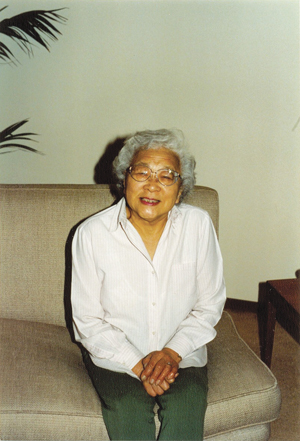By Vivian Luu
Northwest Asian Weekly

Kiyoko "Kay" Seto, wife and mother to Matt and Doug Seto, died from kidney failure in 2000. She inspired Matt and Doug to create the Kiyoko A. Seto Research Endowment at the Northwest Kidney Centers. (Photo provided by Doug Seto)
Clyde Shields, a uremia patient, was saved 50 years ago by the first successful dialysis treatment at the University of Washington Hospital (now the UW Medical Center). If a person had lived with kidney disease before then, or with a related illness such as uremia, that person could be treated only if he or she had a twin and had access to a center that would perform a kidney transplant.
Only 32 in 1,000 babies born are twins.
“It was this kind of research that has brought us to where we are today,” said Matthew Seto, 89. He and his son, Doug Seto, started the Kiyoko A. Seto Research Endowment at the Northwest Kidney Centers (NKC) Foundation in honor of their wife and mother, who died from kidney failure.
The Seto family learned of the late Kiyoko Seto’s illness in 1994. Her kidneys started failing in 1995.
“She went in for a routine checkup,” Doug Seto, who is also on the NKC board, said. “She went in a lot because she had diabetes, which caused her kidneys to fail. The doctors started seeing a lot of water retention, and that’s how we found out that she had [kidney disease].”
Over the next five years, she underwent peritoneal dialysis. Doctors placed a catheter in her abdomen, which she regularly filled with dialysis fluids. Extra fluid and waste products are drawn into the fluids, allowing blood to be cleansed right inside the body.
She could do it at home, Matthew Seto said, and that helped her stay independent.
“Her father had diabetes,“ he said. “Her sister and brother weren’t affected, but she just inherited the gene.”
Studies have shown a hereditary link to diabetes, as well as lifestyle-induced diabetes.

Father Matt Seto (left) and son Doug created a $120,000 endowment at the Northwest Kidney Centers, which has gone toward building the Kidney Research Institute, a joint project between Northwest Kidney Centers and UW Medicine.
But Seto said life didn’t change much for him and his wife. They stuck to their daily routine. They traveled, went mushroom hunting, and spent time together.
Kiyoko Seto died in November 2000. She was 83.
Doug Seto said that the $120,000 endowment was originally for research through NKC on diabetes as it related to kidney disease.
“We wanted something so that even beyond our lifetime and our family’s lifetime, she’d be remembered for doing something good,” he said. “We wanted something that would make a lasting impact.”
Seto added that he had always been interested in research and science: studying the treatment of illness, development of medications, and finding other ways to extend life and eliminate diseases. Giving money toward research on diabetes and kidney disease was the best way to honor his mother.
So far, funds have gone toward building the Kidney Research Institute. The project started in 2008 as a partnership between the Northwest Kidney Centers and UW Medicine.
“We had to raise the initial $2 million to commit to [building the institute],” said Cindy McRoberts, major gifts officer at NKC. “The Seto Endowment helped us do that.”
Along with kidney disease and diabetes research, money from the Seto Endowment goes toward maintaining the Kidney Research Institute, Doug Seto said. “It was donated to get the institute going. The money was used for the infrastructure,” he said. “Now, it fills in for areas you can’t get money for.”
Those areas, for example, include the cost of patients’ transportation to treatment centers as well as scholarships to those who can no longer work in certain industries because of their illness and need training in different fields.
Free Asian Pacific Islander Kidney Health Fair
There will be free blood pressure checks, entertainment, and the chance to ask questions of kidney expert Dr. Danh Ngo, courtesy of Northwest Kidney Centers.
Where: Great Wall Shopping Mall, 18230 E. Valley Highway, in Kent.
When: Saturday, May 22, from noon to 4 p.m.
The money went to a good cause, Matthew Seto said, adding that he wanted to find out how research would ease the situation — how those with diabetes and those suffering from kidney disease could be more at ease.
“How else are you going to learn about people going through the ordeal?”
Each year, Seto adds to the endowment fund from his individual retirement account. Family friends have also made contributions to the endowment, McRoberts said.
“In 10 years, funds from the endowment could go to research in areas such as kidney disease as it relates to obesity and kidney disease in different minority groups,” McRoberts said. “There’s always research to be done until we find a lasting cure [to kidney disease].” ♦
Vivian Luu can be reached at info@nwasianweekly.com.



